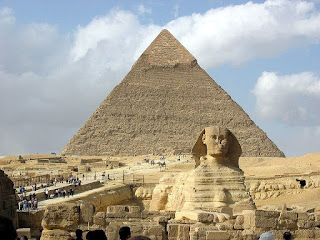Before flying down to Luxor (we were discouraged from taking the train), we first spent some days in Cairo, visiting the Museum of Egyptian Antiquities there. We also didn't miss a visit to nearby Giza to see the Sphinx and the Pyramids.
Seeing these marvels was marvelous in itself; I literally had to keep pinching myself to believe that it was happening. I could have spent weeks, even months just in the museum alone. There was so much to see there, including the treasures that were removed from Tutankhamun's tomb.
After the flight to Luxor, we were surprised to be met at the airport by a young Egyptian woman, Copt as it turned out, who would prove to be our personal escort. Keep in mind that we had booked our Nile cruise from Switzerland. More importantly, keep in mind that Egyptian tourism had been plagued by terrorist attacks, one occurring in 1997 at Deir el-Bahri, an archaeological site located across the Nile from Luxor. Deir el-Bahri is one of the top tourist attractions in Egypt, most notably for the spectacular mortuary temple of the 18th-dynasty female Pharaoh Hatshepsut.
On that tragic day in November 1997 and in this spectacular setting, 62 people lost their lives at the hands of six attackers, disguised as members of the Egyptian security forces. Four Egyptians were among those killed, three of them police officers and one a tour guide. A total of 58 foreign tourists were killed, among them 36 Swiss, ten Japanese, six British, four Germans and other nationalities. Twelve Swiss, two Germans, one French, and nine Egyptians were among the wounded. Because the Swiss were the tourist group most affected, this massacre had the practical effect of stopping Swiss tourism to Egypt in its tracks for some years. What a shame!
Because we had booked through a Swiss travel agency and had travelled to Egypt from Switzerland, we were heralded with great fanfare, even though we were not actually Swiss nationals. The Egyptians that we met chose to believe that we were the vanguard of a much hoped-for return of Swiss tourists and were very excited and happy about that. I hope that we were such a vanguard. Whatever its socio-political problems, Egypt is a country that is so rich in history, culture and extraordinary monuments that it should not be missed. Its citizens are still among its richest resources. We found them uniformly welcoming and delightful.
Our boat was quite new and luxurious. As many have discovered, the cruise boats are much like floating four-star hotels. Ours was no exception.
There were other groups on the boat, notably from Italy and France. There was one group from the UK and one other American couple was travelling with that group. Our "group" was composed uniquely of HWMBO and myself. Dinner seating was assigned by group so HWMBO and I spent most of the time dining in solitary splendor. Because the Government of Egypt was very concerned not to have anything like the 1997 Massacre happen ever again, we had heavily armed escorts in convoy formation to any sights that were not right in the cities next to the river. This included visits to the temple of Hathor, the complex at Deir el-Bahri and the tombs in the Valley of the Kings.
Egyptology is a major field of archaeology and includes the study of ancient Egyptian history, language, literature, religion, and art from the 5th millennium BC until the end of its native religious practices in the AD 4th century. Modern Egyptology was initiated with Napoleon Bonaparte's conquest of Egypt (1798-1800). Although that conquest was extremely short-lived, its long-term consequences were spectacular. Napoleon brought several scientists with his army and they did a remarkable job of describing, drawing and cataloging all the ancient Egyptian temples and antiquities that they found, as well as the fauna and flora of the country. But one of the most important discoveries was that of the Rosetta Stone by a French soldier. Because the Rosetta Stone contained three translations of a single text in Classical Greek, Egyptian hieroglyphics and Egyptian Demotic script respectively, studying the comparative translations provided the key to decipher the language used by the Pharaohs. It was in 1822, when Jean-François Champollion deciphered parts of the Rosetta Stone, showing that the Egyptian writing system was a combination of phonetic and ideographic signs, that Modern Egyptology "officially" began.
Thus, what we can see in Egypt today has been interpreted from the work begun by those early scientists and discoverers. And, as we have seen this week, our knowledge is far from being complete.






I am delighted to know that you appriated the trip to Egypt although neither of us was really prepared for all that we saw. I am currently considering plans for a trip to Peru this fall. Let me know your availability and if this meets your plans. There is still time to read up on the area and get prepared. Some days it will be beyond 10K feet altitude and I will have to get a new camera for the scenes.
ReplyDeleteSounds great to me! But didn't they just have some trouble there getting people out of Macchu Picchu?
ReplyDelete